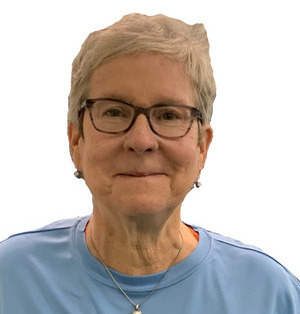My Father did everything to promote my success, and so it was with tennis. By age seven or eight, I was involved in a variety of sports, but tennis was the one sport I could play with my Father. We had a standing weekend date at the Mt. Lebanon courts―outside in the summer, in the bubbles when autumn set in. He would challenge me through a variety of games, starting with hitting 10-in-a-row and, if successful, treated me to lunch at McDonald’s afterwards. Yes! the stuff of childhood bliss..
I started competing on Sundays in the Mt. Lebanon Junior Team Tennis program when I was 10 years old, and continued competing in high school, mostly playing doubles. The girls’ team won WPIALs every year. It seemed very much part of the community vibe.
At Ithaca College, I continued playing doubles and played on the girls’ softball team. My studies were in the field of speech pathology and audiology, which continued to capture both time and attention when pursuing a master’s degree at Pitt. Once launched, my career in the healthcare industry expanded significantly in the rehabilitation arena, culminating with serving as manager of a hospice program. After completing a post-master’s program in Bio Ethics at Duquesne University, I served as Chair of the Ethics Committee at AHN. In my free time, I returned to tennis, playing socially.
In the late-1980s, I met Jan Irwin at the Upper St. Clair Courts and became acquainted with USCTDP. Jan invited me to try my hand at teaching, which turned out to be great fun, so I pursued PTR accreditation. In addition to a 100-question written exam, PTR certification requires being able to teach, demonstrate, and make corrections to a novice’s forehand, backhand, volley, and serve. Founded in 1976 by the late Dennis Van der Mer, PTR is the only USTA-accredited teaching organization. Teaching tennis to students of all ages, starting at three and up to the age of 85, fuels happiness and fulfillment in my life.
Looking back, my Father gave me a gift that keeps on giving―and the same is true for the parents of students in our program. Whether our students aspire to becoming world-class players, or to enhancing their exercise and form, or to reaping social connections now and later in life, playing tennis promotes self-confidence, maturity, and good behaviors―gifts that hold their value forever.
KNOW YOUR PRO
Favorite Female Pro: Chrissy Evert
An 18-time Grand Slam champion who dominated the women's roster through the 1970s and the 1980s, Chrissy Evert acknowledged “I wasn't a naturally strong athlete like Martina Navratilova, Steffi Graf, or Serena Williams. I realized at a young age that my temperament―by being calm and cool on the court and by being present in every single point and trying to win every single point and being strong mentally―that was the strength of my game.” I admire Chrissy’s temperament tremendously.
Favorite Male Pro: Roger Federer
Mats Wilander, Boris Becker, John McEnroe, Serena Williams―even Shaquille O'Neal use the same four words to describe Roger: “He’s a class act.” I couldn’t agree more.
Favorite Tournament: Family Circle Cup (when hosted in Hilton Head, SC)
Back in 1973, the Family Circle Cup was a pioneer in women's professional tennis. It was the first women's tennis event to be broadcast nationally, and the first to offer $100,000 dollars in prize money. Rosie Casals received a check for $30,000, which was the largest prize money awarded to a woman that year―a far cry from the $3 million Coco Gauff pocketed after winning the 2023 US Open. (By the way, the same amount was awarded to the male winner, Novak Djokovic.) After 28 years in Hilton Head, the tournament moved to Charleston, South Carolina in 2001. While still my favorite tournament, I miss visiting Hilton Head and being part of this marvelous history.
Favorite Stroke: Volley
The volley is the best part of my game. I have no fear at the net and, coupled with quick reflexes, the volley feels effortless and graceful. Plus, at the net, there’s a wider choice of angles to hit into the opponent’s court, making it my favorite offensive stroke.
